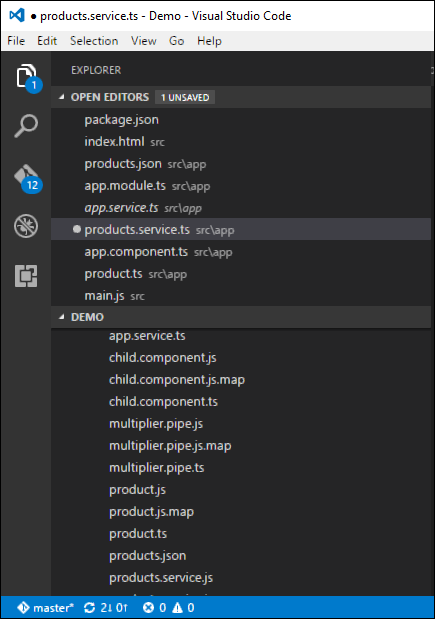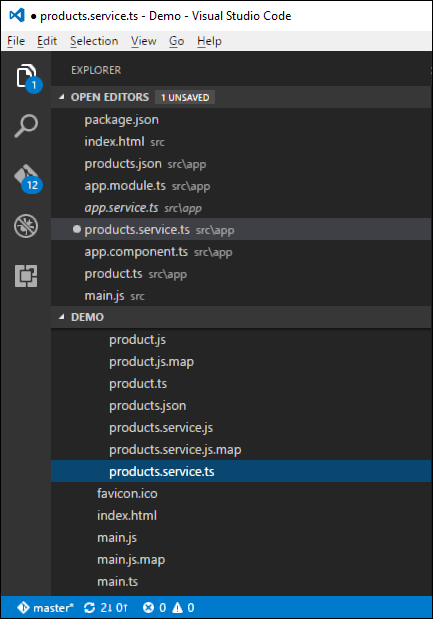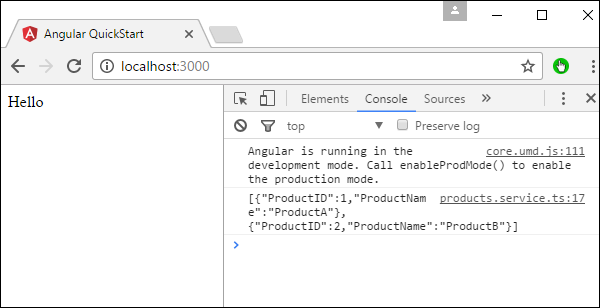
- Angular 2 教程
- Angular 2 - 首頁
- Angular 2 - 概述
- Angular 2 - 環境
- Angular 2 - Hello World
- Angular 2 - 模組
- Angular 2 - 架構
- Angular 2 - 元件
- Angular 2 - 模板
- Angular 2 - 指令
- Angular 2 - 元資料
- Angular 2 - 資料繫結
- 使用 HTTP 進行 CRUD 操作
- Angular 2 - 錯誤處理
- Angular 2 - 路由
- Angular 2 - 導航
- Angular 2 - 表單
- Angular 2 - CLI
- Angular 2 - 依賴注入
- Angular 2 - 高階配置
- Angular 2 - 第三方控制元件
- Angular 2 - 資料顯示
- Angular 2 - 處理事件
- Angular 2 - 資料轉換
- Angular 2 - 自定義管道
- Angular 2 - 使用者輸入
- Angular 2 - 生命週期鉤子
- Angular 2 - 巢狀容器
- Angular 2 - 服務
- Angular 2 有用資源
- Angular 2 - 問答
- Angular 2 - 快速指南
- Angular 2 - 有用資源
- Angular 2 - 討論
Angular 2 - 使用 HTTP 進行 CRUD 操作
我們將在本章中探討的基本 CRUD 操作是從 Web 服務中使用 Angular 2 讀取資料。
示例
在這個示例中,我們將定義一個數據源,它是一個簡單的json產品檔案。接下來,我們將定義一個服務,該服務將用於從json檔案中讀取資料。然後,我們將在我們的 main app.component.ts 檔案中使用此服務。
步驟 1 - 首先,讓我們在 Visual Studio Code 中定義我們的 product.json 檔案。

在 products.json 檔案中,輸入以下文字。這將是從 Angular JS 應用程式中獲取的資料。
[{
"ProductID": 1,
"ProductName": "ProductA"
},
{
"ProductID": 2,
"ProductName": "ProductB"
}]
步驟 2 - 定義一個介面,它將是類定義,用於儲存來自我們的 products.json 檔案的資訊。建立一個名為 products.ts 的檔案。

步驟 3 - 在檔案中插入以下程式碼。
export interface IProduct {
ProductID: number;
ProductName: string;
}
上述介面將 ProductID 和 ProductName 定義為介面的屬性。
步驟 4 - 在 app.module.ts 檔案中包含以下程式碼 -
import { NgModule } from '@angular/core';
import { BrowserModule } from '@angular/platform-browser';
import { AppComponent } from './app.component';
import { HttpModule } from '@angular/http';
@NgModule ({
imports: [ BrowserModule,HttpModule],
declarations: [ AppComponent],
bootstrap: [ AppComponent ]
})
export class AppModule { }
步驟 5 - 在 Visual Studio Code 中定義一個 products.service.ts 檔案

步驟 6 - 在檔案中插入以下程式碼。
import { Injectable } from '@angular/core';
import { Http , Response } from '@angular/http';
import { Observable } from 'rxjs/Observable';
import 'rxjs/add/operator/map';
import 'rxjs/add/operator/do';
import { IProduct } from './product';
@Injectable()
export class ProductService {
private _producturl='app/products.json';
constructor(private _http: Http){}
getproducts(): Observable<IProduct[]> {
return this._http.get(this._producturl)
.map((response: Response) => <IProduct[]> response.json())
.do(data => console.log(JSON.stringify(data)));
}
}
關於以上程式,需要注意以下幾點。
import {Http, Response} from '@angular/http' 語句用於確保可以使用 http 函式從 products.json 檔案獲取資料。
以下語句用於使用 Reactive 框架,該框架可用於建立 Observable 變數。Observable 框架用於檢測 http 響應中的任何更改,然後可以將其傳送回主應用程式。
import { Observable } from 'rxjs/Observable';
import 'rxjs/add/operator/map';
import 'rxjs/add/operator/do';
類中的語句 private _producturl = 'app/products.json' 用於指定資料來源的位置。如果需要,它也可以指定 Web 服務的位置。
接下來,我們定義一個 Http 型別的變數,該變數將用於獲取來自資料來源的響應。
從資料來源獲取資料後,我們使用 JSON.stringify(data) 命令將資料傳送到瀏覽器的控制檯。
步驟 7 - 現在在 app.component.ts 檔案中,放置以下程式碼。
import { Component } from '@angular/core';
import { IProduct } from './product';
import { ProductService } from './products.service';
import { appService } from './app.service';
import { Http , Response } from '@angular/http';
import { Observable } from 'rxjs/Observable';
import 'rxjs/add/operator/map';
@Component ({
selector: 'my-app',
template: '<div>Hello</div>',
providers: [ProductService]
})
export class AppComponent {
iproducts: IProduct[];
constructor(private _product: ProductService) {
}
ngOnInit() : void {
this._product.getproducts()
.subscribe(iproducts => this.iproducts = iproducts);
}
}
這裡,程式碼中的主要內容是 subscribe 選項,它用於偵聽 Observable getproducts() 函式以偵聽來自資料來源的資料。
現在儲存所有程式碼並使用npm執行應用程式。轉到瀏覽器,我們將看到以下輸出。

在控制檯中,我們將看到從 products.json 檔案檢索到的資料。